 The Battle The battle for Caen from June-August 1944 was a battle between Allied (primarily British and Canadian troops) andGerman forces during the Battle of Normandy.
The Battle The battle for Caen from June-August 1944 was a battle between Allied (primarily British and Canadian troops) andGerman forces during the Battle of Normandy.
check out this great blog http://ww2pts.blogspot.com/
thanks on caen

In 1346 King Edward III of England led his army against the city hoping to loot it. On 26 July 1346 his troops stormed the city and sacked it, killing 3,000 of its citizens and burning much of the merchants' quarter. During the attack English officials searched its archives and found a copy of the 1339 Franco-Norman plot to invade England, devised byPhilip VI of France
On 26 July 1346 his troops stormed the city and sacked it, killing 3,000 of its citizens and burning much of the merchants' quarter. During the attack English officials searched its archives and found a copy of the 1339 Franco-Norman plot to invade England, devised byPhilip VI of France 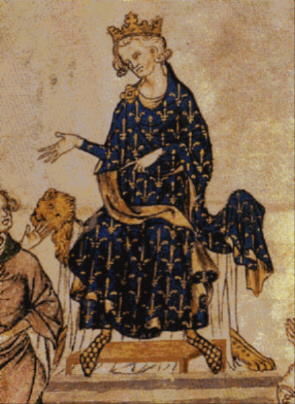 and Normandy.The Ordinance of Normandy is the name given to a paper authored by Philip VI of France on 23 March 1338. It called for a second Norman conquest of England, with an invading army led by the Duke of Normandy, and England was to be divided between the Duke of Normandy and his nobles as a fief for the King of France. It was discovered by the English army at Caen in 1346. After it was carried back to England by the Earl of Huntingdon
and Normandy.The Ordinance of Normandy is the name given to a paper authored by Philip VI of France on 23 March 1338. It called for a second Norman conquest of England, with an invading army led by the Duke of Normandy, and England was to be divided between the Duke of Normandy and his nobles as a fief for the King of France. It was discovered by the English army at Caen in 1346. After it was carried back to England by the Earl of Huntingdon when he was invalided home it was read out in St. Paul's in London by the Archbishop of Canterbury, John de Stratford.
when he was invalided home it was read out in St. Paul's in London by the Archbishop of Canterbury, John de Stratford.
 On 26 July 1346 his troops stormed the city and sacked it, killing 3,000 of its citizens and burning much of the merchants' quarter. During the attack English officials searched its archives and found a copy of the 1339 Franco-Norman plot to invade England, devised byPhilip VI of France
On 26 July 1346 his troops stormed the city and sacked it, killing 3,000 of its citizens and burning much of the merchants' quarter. During the attack English officials searched its archives and found a copy of the 1339 Franco-Norman plot to invade England, devised byPhilip VI of France  and Normandy.The Ordinance of Normandy is the name given to a paper authored by Philip VI of France on 23 March 1338. It called for a second Norman conquest of England, with an invading army led by the Duke of Normandy, and England was to be divided between the Duke of Normandy and his nobles as a fief for the King of France. It was discovered by the English army at Caen in 1346. After it was carried back to England by the Earl of Huntingdon
and Normandy.The Ordinance of Normandy is the name given to a paper authored by Philip VI of France on 23 March 1338. It called for a second Norman conquest of England, with an invading army led by the Duke of Normandy, and England was to be divided between the Duke of Normandy and his nobles as a fief for the King of France. It was discovered by the English army at Caen in 1346. After it was carried back to England by the Earl of Huntingdon
King Philip vowed to "destruire & anientier tote la Nation & la Lange Engleys" [destroy and eliminate the entire English nation and language].This was subsequently used as propaganda to justify the supplying and financing of the conflict and its continuation. Only the castle of Caen held out, despite attempts to besiege it. A few days later the English left, marching to the east and on to their victory at the Battle of Crécy. It was later captured by Henry V in 1417 and treated harshly for being the first town to put up any resistance to his invasion.

During the Battle of Normandy in the Second World War, Caen was liberated in early July, a month after the Normandy landings, particularly those by British I Corps on 6 June 1944. British and Canadian troops had intended to capture the town on D-Day. However they were held up north of the city until 9 July, when an intense bombing campaign duringOperation Charnwood destroyed much of the city but allowed the Allies to seize its western quarters, a month later than Montgomery's original plan. During the battle, man y of the town's inhabitants sought refuge in the Abbaye aux Hommes ("Men's Abbey"), built by William the Conqueror some 800 years before.
y of the town's inhabitants sought refuge in the Abbaye aux Hommes ("Men's Abbey"), built by William the Conqueror some 800 years before.
 y of the town's inhabitants sought refuge in the Abbaye aux Hommes ("Men's Abbey"), built by William the Conqueror some 800 years before.
y of the town's inhabitants sought refuge in the Abbaye aux Hommes ("Men's Abbey"), built by William the Conqueror some 800 years before.
Post-Second World War work included the reconstruction of complete districts of the city and the university campus. It took 14 years (1948–1962) and led to the current urbanization of Caen. Having lost many of its historic quarters and its university campus in the war, the city does not possess what some might call the 'feel' of a traditional Normandy town such as Honfleur, Rouen,
Rouen,  Cabourg
Cabourg , Deauville
, Deauville and Bayeux
and Bayeux .
.
The Canadian Army Film and Photo Unit filmed the D-Day offensive and Orne breakout several weeks later, then returned several months later to document the town's recovery efforts. The resulting film You Can't Kill a City is preserved in the National Archives of Canada. Caen was a vital objective for several reasons. Firstly, it lay astride the Orne River Rouen,
Rouen,  Cabourg
Cabourg , Deauville
, Deauville and Bayeux
and Bayeux .
.
and Caen Canal

; these two water obstacles could strengthen a German defensive position if not crossed. Secondly, Caen was a road hub; in German hands it would enable the enemy to shift forces rapidly. Thirdly, the area around Caen was relatively open, especially compared to the bocage

On D-Day, Caen was an objective for the British 3rd Infantry Division and remained the focal point for a series of battles throughout June, July and into August.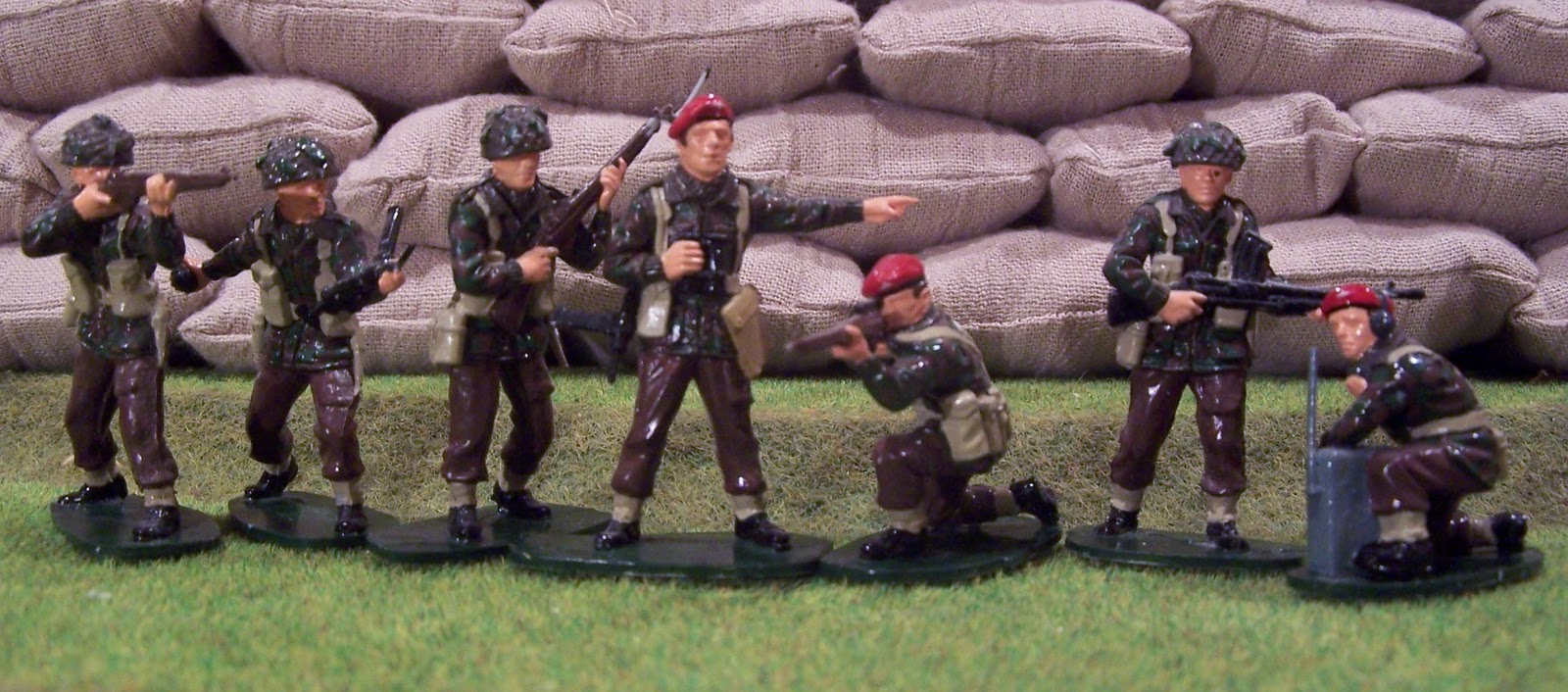

The old city of Caen—with many buildings dating back to the Middle Ages—was largely destroyed by Allied bombing and the fighting. The reconstruction of Caen lasted until 1962. Today, little of the pre-war city remains.
the fighting. The reconstruction of Caen lasted until 1962. Today, little of the pre-war city remains.
 the fighting. The reconstruction of Caen lasted until 1962. Today, little of the pre-war city remains.
the fighting. The reconstruction of Caen lasted until 1962. Today, little of the pre-war city remains.
D.Day
The British 6th Airborne Division at the eastern end captured key bridges over the Caen Canal and Orne River. When the seaborne units began to land about 6:30 AM on June 6, the allied soldiers stormed the beaches against fierce opposition from German gun positions and mined beach obstacles. The soldiers raced across the wide-open beaches swept with
fierce opposition from German gun positions and mined beach obstacles. The soldiers raced across the wide-open beaches swept with machine gun fire, and stormed the gun positions. In fierce hand-to-hand fighting, they fought their way into the towns and hills and then advanced inland.
machine gun fire, and stormed the gun positions. In fierce hand-to-hand fighting, they fought their way into the towns and hills and then advanced inland.
 fierce opposition from German gun positions and mined beach obstacles. The soldiers raced across the wide-open beaches swept with
fierce opposition from German gun positions and mined beach obstacles. The soldiers raced across the wide-open beaches swept with machine gun fire, and stormed the gun positions. In fierce hand-to-hand fighting, they fought their way into the towns and hills and then advanced inland.
machine gun fire, and stormed the gun positions. In fierce hand-to-hand fighting, they fought their way into the towns and hills and then advanced inland.
By the end of the day the 3rd British Division was within three miles of Caen, the 3rd Canadian Division was well established on its intermediate objectives and the 50th Division was only two miles from Bayeux. In the American zone, the 4th Division had established a 4-mile deep penetration inland and was within reach of
In the American zone, the 4th Division had established a 4-mile deep penetration inland and was within reach of  Ste-Mere-Eglise, where the 82nd had fought throughout the night. The assault forces at "Omaha" beach had met fierce resistance, incurring
Ste-Mere-Eglise, where the 82nd had fought throughout the night. The assault forces at "Omaha" beach had met fierce resistance, incurring significant casualties, but here too, beachheads had been established.
significant casualties, but here too, beachheads had been established.
 In the American zone, the 4th Division had established a 4-mile deep penetration inland and was within reach of
In the American zone, the 4th Division had established a 4-mile deep penetration inland and was within reach of  significant casualties, but here too, beachheads had been established.
significant casualties, but here too, beachheads had been established.
It was a magnificent accomplishment; the formidable Atlantic Wall had been successfully breached. By the end of D-Day, the Allies had landed more than 150,000 troops in France by sea and air, 6,000 vehicles including 900
D-Day, the Allies had landed more than 150,000 troops in France by sea and air, 6,000 vehicles including 900 tanks, 600 guns and about 4,000 tons of supplies and, astonishingly, had achieved complete surprise in doing it.
tanks, 600 guns and about 4,000 tons of supplies and, astonishingly, had achieved complete surprise in doing it. More soldiers and supplies were pouring ashore to continue the advance on D-Day-plus-one.
More soldiers and supplies were pouring ashore to continue the advance on D-Day-plus-one. By the evening of June 6th, the tanks of the 21st Panzer Division, reinforced later that night by those of the 12th SS Hitlerjugend, had formed a barrier of fire and steel in front of Caen, which stopped the Allies in their tracks and banished all hopes of early deliverance for
By the evening of June 6th, the tanks of the 21st Panzer Division, reinforced later that night by those of the 12th SS Hitlerjugend, had formed a barrier of fire and steel in front of Caen, which stopped the Allies in their tracks and banished all hopes of early deliverance for the thousands of civilians who had not fled the city after the initial bombings. The German commander brought his best divisions into play, notably most of his armoured units. The British and Canadians were pinned down in the cornfields around the city. Caen was to
the thousands of civilians who had not fled the city after the initial bombings. The German commander brought his best divisions into play, notably most of his armoured units. The British and Canadians were pinned down in the cornfields around the city. Caen was to  become the linchpin of the Battle of Normandy.
become the linchpin of the Battle of Normandy.
 D-Day, the Allies had landed more than 150,000 troops in France by sea and air, 6,000 vehicles including 900
D-Day, the Allies had landed more than 150,000 troops in France by sea and air, 6,000 vehicles including 900 tanks, 600 guns and about 4,000 tons of supplies and, astonishingly, had achieved complete surprise in doing it.
tanks, 600 guns and about 4,000 tons of supplies and, astonishingly, had achieved complete surprise in doing it. More soldiers and supplies were pouring ashore to continue the advance on D-Day-plus-one.
More soldiers and supplies were pouring ashore to continue the advance on D-Day-plus-one. By the evening of June 6th, the tanks of the 21st Panzer Division, reinforced later that night by those of the 12th SS Hitlerjugend, had formed a barrier of fire and steel in front of Caen, which stopped the Allies in their tracks and banished all hopes of early deliverance for
By the evening of June 6th, the tanks of the 21st Panzer Division, reinforced later that night by those of the 12th SS Hitlerjugend, had formed a barrier of fire and steel in front of Caen, which stopped the Allies in their tracks and banished all hopes of early deliverance for the thousands of civilians who had not fled the city after the initial bombings. The German commander brought his best divisions into play, notably most of his armoured units. The British and Canadians were pinned down in the cornfields around the city. Caen was to
the thousands of civilians who had not fled the city after the initial bombings. The German commander brought his best divisions into play, notably most of his armoured units. The British and Canadians were pinned down in the cornfields around the city. Caen was to  become the linchpin of the Battle of Normandy.
become the linchpin of the Battle of Normandy.
Late on D-Day plus 1, in the area on the left of the Canadian assault, the North Nova Scotia Highlanders, supported by the Sherbrooke Fusiliers, tried to break through to the Abbaye d’Ardenne, a distance of some five miles. The North Novas had leapfrogged through the
a distance of some five miles. The North Novas had leapfrogged through the Queens Own Rifles and the Chaudières. They had no inkling of what lay in store. It was to be the first encounter with the Hitler Jugend
Queens Own Rifles and the Chaudières. They had no inkling of what lay in store. It was to be the first encounter with the Hitler Jugend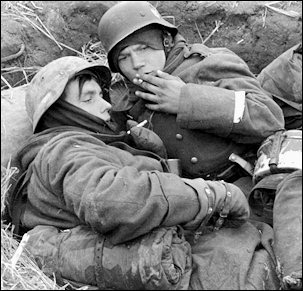
 a distance of some five miles. The North Novas had leapfrogged through the
a distance of some five miles. The North Novas had leapfrogged through the Queens Own Rifles and the Chaudières. They had no inkling of what lay in store. It was to be the first encounter with the Hitler Jugend
Queens Own Rifles and the Chaudières. They had no inkling of what lay in store. It was to be the first encounter with the Hitler Jugend
By the spring of 1944, training was complete. The HJ Panzer Division, now fully trained and equipped, conducted divisional maneuvers observed by General Heinz Guderian and Field Marshal Gerd von Rundstedt, both of whom admired the enthusiasm and expressed their high approval of the proficiency achieved by the young troops in such a short time. The division was then transferred to Hasselt, Belgium, in anticipation of D-Day, the Allied invasion of northern France. A few days before the invasion, SS-
in anticipation of D-Day, the Allied invasion of northern France. A few days before the invasion, SS- Reichsführer Heinrich Himmler visited the division. On D-Day, June 6th, 1944, the HJ Division was one of three Panzer divisions held in reserve by Hitler as the Allies stormed the beaches at Normandy beginning at dawn. At 2:30 in the afternoon, the HJ Division was released and sent to Caen, located not far inland from Sword and Juno beaches on which British and Canadian troops had landed. The division soon came under heavy strafing attacks from Allied fighter bombers, which delayed arrival there until 10 p.m.
Reichsführer Heinrich Himmler visited the division. On D-Day, June 6th, 1944, the HJ Division was one of three Panzer divisions held in reserve by Hitler as the Allies stormed the beaches at Normandy beginning at dawn. At 2:30 in the afternoon, the HJ Division was released and sent to Caen, located not far inland from Sword and Juno beaches on which British and Canadian troops had landed. The division soon came under heavy strafing attacks from Allied fighter bombers, which delayed arrival there until 10 p.m.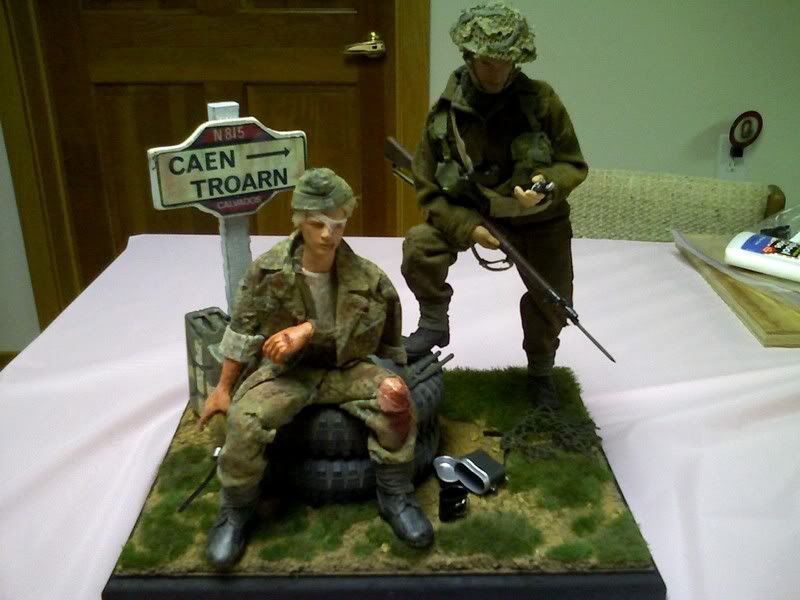
The HJ were off to face an enemy that now had overwhelming air superiority and would soon have nearly unlimited artillery support. The Allies, for their part, were about to have their first encounter with Hitler's fanatical boy-soldiers. in anticipation of D-Day, the Allied invasion of northern France. A few days before the invasion, SS-
in anticipation of D-Day, the Allied invasion of northern France. A few days before the invasion, SS- Reichsführer Heinrich Himmler visited the division. On D-Day, June 6th, 1944, the HJ Division was one of three Panzer divisions held in reserve by Hitler as the Allies stormed the beaches at Normandy beginning at dawn. At 2:30 in the afternoon, the HJ Division was released and sent to Caen, located not far inland from Sword and Juno beaches on which British and Canadian troops had landed. The division soon came under heavy strafing attacks from Allied fighter bombers, which delayed arrival there until 10 p.m.
Reichsführer Heinrich Himmler visited the division. On D-Day, June 6th, 1944, the HJ Division was one of three Panzer divisions held in reserve by Hitler as the Allies stormed the beaches at Normandy beginning at dawn. At 2:30 in the afternoon, the HJ Division was released and sent to Caen, located not far inland from Sword and Juno beaches on which British and Canadian troops had landed. The division soon came under heavy strafing attacks from Allied fighter bombers, which delayed arrival there until 10 p.m.

The shocking fanaticism and reckless bravery of the Hitler Youth in battle astounded the British and Canadians who fought them. They sprang like wolves against tanks. If they were encircled or outnumbered, they fought-on until there
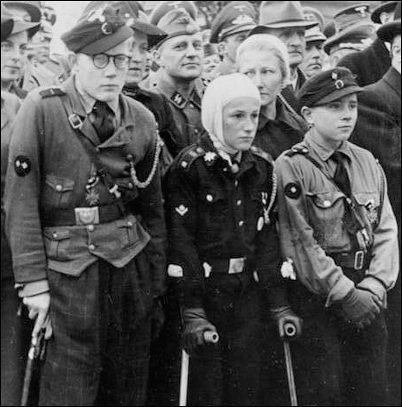
were no survivors. Young boys, years away from their first shave, had to be shot dead by Allied soldiers, old enough, in some cases, to be their fathers. The "fearless, cruel, domineering" youth Hitler had wanted had now come of age and arrived on the battlefield with utter contempt for danger and little regard for their own lives. This soon resulted in the near destruction of the entire division.
By the end of its first month in battle, 60 percent of the HJ Division was knocked out of action, with 20 percent killed and the rest wounded and missing. Divisional Commander Witt was killed by a direct hit on his  headquarters from a British warship. Command then passed to Kurt Meyer, nicknamed 'Panzermeyer,'
headquarters from a British warship. Command then passed to Kurt Meyer, nicknamed 'Panzermeyer,' who at age 33, became the youngest divisional commander in the entire German armed forces.After Caen fell to the British, the HJ Division was withdrawn from the Normandy Front. The once confident fresh-faced Nazi youths were now exhausted and filthy, a sight which "presented a picture of deep human misery" as described by Meyer.
who at age 33, became the youngest divisional commander in the entire German armed forces.After Caen fell to the British, the HJ Division was withdrawn from the Normandy Front. The once confident fresh-faced Nazi youths were now exhausted and filthy, a sight which "presented a picture of deep human misery" as described by Meyer.OBNdVLnl24g~~0_12.JPG)
In August, the Germans mounted a big counter-offensive toward Avranches, but were pushed back from the north by the British and Canadians, and by the Americans from the west, into the area around Falaise. Twenty four German divisions were trapped inside the Falaise Pocket with a narrow 20 mile gap existing as the sole avenue of escape. The HJ Division was sent to keep the northern edge of this gap open. headquarters from a British warship. Command then passed to Kurt Meyer, nicknamed 'Panzermeyer,'
headquarters from a British warship. Command then passed to Kurt Meyer, nicknamed 'Panzermeyer,' who at age 33, became the youngest divisional commander in the entire German armed forces.After Caen fell to the British, the HJ Division was withdrawn from the Normandy Front. The once confident fresh-faced Nazi youths were now exhausted and filthy, a sight which "presented a picture of deep human misery" as described by Meyer.
who at age 33, became the youngest divisional commander in the entire German armed forces.After Caen fell to the British, the HJ Division was withdrawn from the Normandy Front. The once confident fresh-faced Nazi youths were now exhausted and filthy, a sight which "presented a picture of deep human misery" as described by Meyer.However, Allied air superiority and massive artillery barrages smashed the HJ as well as the Germans trapped inside the pocket. Over 5,000 armored vehicles were destroyed, with 50,000 Germans captured, while 20,000 managed to escape, including the tattered remnants of the HJ.
By September 1944, the 12th SS-Panzer Division Hitlerjugend numbered only 600 surviving young soldiers, with no tanks and no ammunition. Over 9,000 had been lost in Normandy and Falaise. The division continued to exist in name only for the duration of the war, as even younger (and still eager) volunteers were brought in along with a hodgepodge of conscripts. The division participated in the failed Battle of the Bulge (Ardennes Offensive) and was then sent to Hungary where it participated in the failed attempt to recapture Budapest. On May 8, 1945, numbering just 455 soldiers and one tank, the 12th SS-Panzer Division Hitlerjugend surrendered to the American 7th Army. The victory was a turning point in World War II and led to the liberation of Europe and the defeat of Nazi Germany.
The victory was a turning point in World War II and led to the liberation of Europe and the defeat of Nazi Germany.
The 9th SS Panzer Division "Hohenstaufen", also known as SS-Panzergrenadier-Division 9, SS-Panzergrenadier-Division 9 Hohenstaufen or 9. SS-Panzer-Division Hohenstaufen, was a German Waffen-SS Armoured division which saw action on both the Eastern and Western Fronts during World War II. The division was activated on the 31 December 1942. The men of the division were German conscripts aged 18, with a cadre of experienced staff from the Leibstandarte SS Adolf Hitler. Their first action was in March 1944, in Poland they were then moved to Normandy in June 1944. After the retreat from France they were moved to Arnhem in September 1944, to rest and refit and became involved in the Allied parachute landings. Their next action was the German advance in the Ardennes in the winter of 1944–1945. After the defeat in the Ardennes they were then moved to Hungary, and took part in the fighting to the west of Budapest in February and March. Falling back into Austria the division surrendered to the advancing United States Army on the 5 May 1945, at Steyr.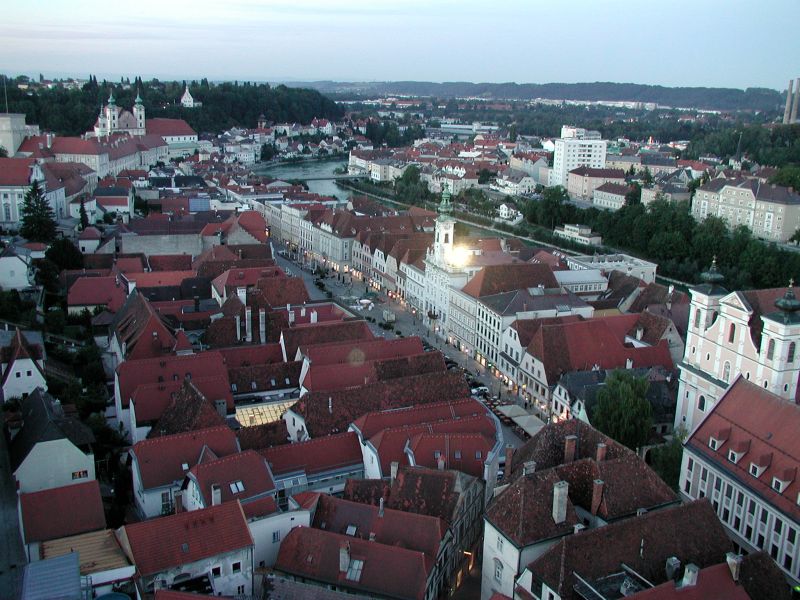
HohenstaufenA first 277th Infantry Division (277. Infanterie-Division) was ordered to form on May 22, 1940 as part of the 10th mobilisation wave (10. Welle), but this order was rescinded after the French Surrender. A new 277th Infantry Division was formed in Croatia on November 17, 1943 as part of the 22nd mobilisation wave (22. Welle), the division was destroyed in the Battle of Normandy in August 1944. A third, 277th Volksgrenadier Division (277. Volksgrenadier-Division) was formed on September 4, 1944 in Hungary by redesignation of the newly formed 574th Volksgrenadier Division (574. Volksgrenadier-Division) of the 32nd mobilisation wave (32. Welle). In 1945 the division entered U.S. captivity in the Ruhr Pocket.
After the launching of another British offensive aimed at taking Caen, Hohenstaufen was again put back into the line, this time defending Hill 112, taking over the positions of the battered Frundsberg. After more heavy fighting, Hohenstaufen was again pulled out of the line on 15 July. The division's depleted Panzergrenadier regiments were merged to form Panzergrenadier Regiment Hohenstaufen. The division saw heavy action defending against British armour during Operation Goodwood, suffering heavy losses, but succeeded in holding the line.
After the launch of the Canadian Operation Totalize, Hohenstaufen performed a fighting withdrawal, avoiding encirclement in the Falaise pocket,
Hohenstaufen performed a fighting withdrawal, avoiding encirclement in the Falaise pocket, and fighting to keep the narrow escape route from this pocket open. By 21 August, the battle of Normandy was over, and the German forces were in full retreat. Obersturmbannführer Walter Harzer
and fighting to keep the narrow escape route from this pocket open. By 21 August, the battle of Normandy was over, and the German forces were in full retreat. Obersturmbannführer Walter Harzer  was now placed in command of the division. The division fought several rearguard actions during the retreat through France and Belgium, and in early September 1944, the exhausted unit was pulled out of the line for rest and refit near the Dutch city of Arnhem.By
was now placed in command of the division. The division fought several rearguard actions during the retreat through France and Belgium, and in early September 1944, the exhausted unit was pulled out of the line for rest and refit near the Dutch city of Arnhem.By this time Hohenstaufen was down to approximately 7,000 men, from 15,900 at the end of June suffered losses from Allied fighter bombers during its move to Normandy, delaying its arrival until 26 June 1944. The original plan for Hohenstaufen to attack towards the Allied beachhead was made impossible by a British offensive to take Caen. The II SS Panzer Corps was instead put into the line to support the weakened forces defending Caen. Hohenstaufen was involved in ferocious fighting until early July, suffering 1,200 casualties. On 10 July, the division was pulled back into reserve, to be replaced by the 277th Infantry Division.
this time Hohenstaufen was down to approximately 7,000 men, from 15,900 at the end of June suffered losses from Allied fighter bombers during its move to Normandy, delaying its arrival until 26 June 1944. The original plan for Hohenstaufen to attack towards the Allied beachhead was made impossible by a British offensive to take Caen. The II SS Panzer Corps was instead put into the line to support the weakened forces defending Caen. Hohenstaufen was involved in ferocious fighting until early July, suffering 1,200 casualties. On 10 July, the division was pulled back into reserve, to be replaced by the 277th Infantry Division.
Operation Goodwood was an attack launched on 18 July 1944, during the Second World War, by the British army to the east of the city of Caen. British VIII Corps led the attack with three armoured divisions, supported by British I Corps on the eastern flank and the Canadian II Corps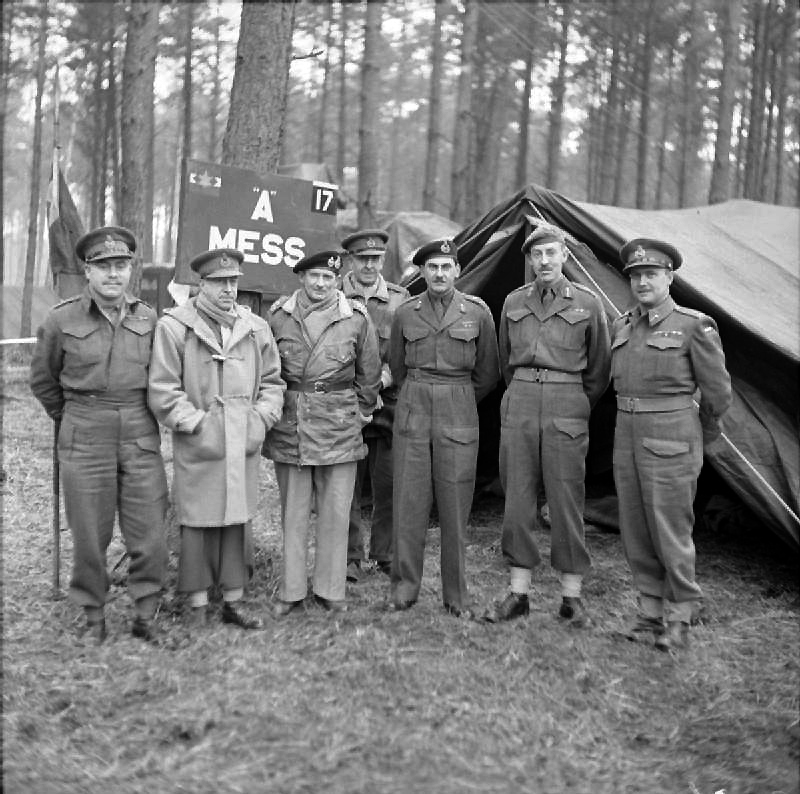 on the western flank, who were launching their own attack codenamed Operation Atlantic, to capture the remainder of Caen.
on the western flank, who were launching their own attack codenamed Operation Atlantic, to capture the remainder of Caen.
When Operation Goodwood ended on 20 July, the armoured divisions had broken through the initial German defences and had advanced 7 miles before coming to a halt in front of the Bourguébus Ridge, although armoured cars had penetrated further south and over the ridge.
There has been controversy since July 1944 over the objective of the operation: whether it was a limited attack to secure Caen and pin German formations in the eastern region of the Normandy beachhead, preventing them from disengaging to join the counterattack against the US Operation Cobra,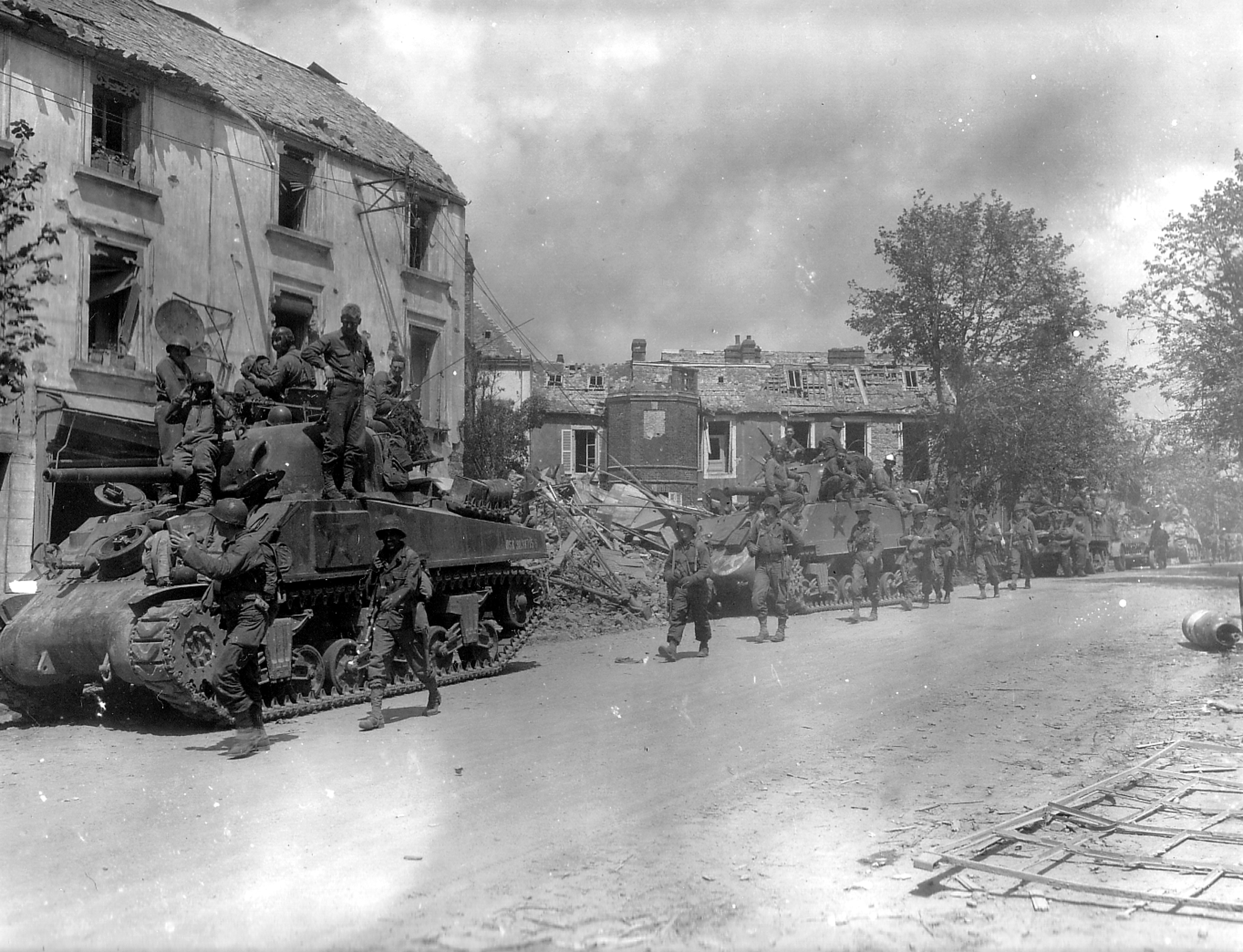 or a failed attempted breakout from the Normandy bridgehead.
or a failed attempted breakout from the Normandy bridgehead.
At least one historian has called the operation the largest tank battle that the British Army has ever fought.
 The victory was a turning point in World War II and led to the liberation of Europe and the defeat of Nazi Germany.
The victory was a turning point in World War II and led to the liberation of Europe and the defeat of Nazi Germany.
The 9th SS Panzer Division "Hohenstaufen", also known as SS-Panzergrenadier-Division 9, SS-Panzergrenadier-Division 9 Hohenstaufen or 9. SS-Panzer-Division Hohenstaufen, was a German Waffen-SS Armoured division which saw action on both the Eastern and Western Fronts during World War II. The division was activated on the 31 December 1942. The men of the division were German conscripts aged 18, with a cadre of experienced staff from the Leibstandarte SS Adolf Hitler. Their first action was in March 1944, in Poland they were then moved to Normandy in June 1944. After the retreat from France they were moved to Arnhem in September 1944, to rest and refit and became involved in the Allied parachute landings. Their next action was the German advance in the Ardennes in the winter of 1944–1945. After the defeat in the Ardennes they were then moved to Hungary, and took part in the fighting to the west of Budapest in February and March. Falling back into Austria the division surrendered to the advancing United States Army on the 5 May 1945, at Steyr.

HohenstaufenA first 277th Infantry Division (277. Infanterie-Division) was ordered to form on May 22, 1940 as part of the 10th mobilisation wave (10. Welle), but this order was rescinded after the French Surrender. A new 277th Infantry Division was formed in Croatia on November 17, 1943 as part of the 22nd mobilisation wave (22. Welle), the division was destroyed in the Battle of Normandy in August 1944. A third, 277th Volksgrenadier Division (277. Volksgrenadier-Division) was formed on September 4, 1944 in Hungary by redesignation of the newly formed 574th Volksgrenadier Division (574. Volksgrenadier-Division) of the 32nd mobilisation wave (32. Welle). In 1945 the division entered U.S. captivity in the Ruhr Pocket.

After the launching of another British offensive aimed at taking Caen, Hohenstaufen was again put back into the line, this time defending Hill 112, taking over the positions of the battered Frundsberg. After more heavy fighting, Hohenstaufen was again pulled out of the line on 15 July. The division's depleted Panzergrenadier regiments were merged to form Panzergrenadier Regiment Hohenstaufen. The division saw heavy action defending against British armour during Operation Goodwood, suffering heavy losses, but succeeded in holding the line.

After the launch of the Canadian Operation Totalize,
 Hohenstaufen performed a fighting withdrawal, avoiding encirclement in the Falaise pocket,
Hohenstaufen performed a fighting withdrawal, avoiding encirclement in the Falaise pocket, and fighting to keep the narrow escape route from this pocket open. By 21 August, the battle of Normandy was over, and the German forces were in full retreat. Obersturmbannführer Walter Harzer
and fighting to keep the narrow escape route from this pocket open. By 21 August, the battle of Normandy was over, and the German forces were in full retreat. Obersturmbannführer Walter Harzer  was now placed in command of the division. The division fought several rearguard actions during the retreat through France and Belgium, and in early September 1944, the exhausted unit was pulled out of the line for rest and refit near the Dutch city of Arnhem.By
was now placed in command of the division. The division fought several rearguard actions during the retreat through France and Belgium, and in early September 1944, the exhausted unit was pulled out of the line for rest and refit near the Dutch city of Arnhem.By this time Hohenstaufen was down to approximately 7,000 men, from 15,900 at the end of June suffered losses from Allied fighter bombers during its move to Normandy, delaying its arrival until 26 June 1944. The original plan for Hohenstaufen to attack towards the Allied beachhead was made impossible by a British offensive to take Caen. The II SS Panzer Corps was instead put into the line to support the weakened forces defending Caen. Hohenstaufen was involved in ferocious fighting until early July, suffering 1,200 casualties. On 10 July, the division was pulled back into reserve, to be replaced by the 277th Infantry Division.
this time Hohenstaufen was down to approximately 7,000 men, from 15,900 at the end of June suffered losses from Allied fighter bombers during its move to Normandy, delaying its arrival until 26 June 1944. The original plan for Hohenstaufen to attack towards the Allied beachhead was made impossible by a British offensive to take Caen. The II SS Panzer Corps was instead put into the line to support the weakened forces defending Caen. Hohenstaufen was involved in ferocious fighting until early July, suffering 1,200 casualties. On 10 July, the division was pulled back into reserve, to be replaced by the 277th Infantry Division.
Operation Goodwood was an attack launched on 18 July 1944, during the Second World War, by the British army to the east of the city of Caen. British VIII Corps led the attack with three armoured divisions, supported by British I Corps on the eastern flank and the Canadian II Corps
 on the western flank, who were launching their own attack codenamed Operation Atlantic, to capture the remainder of Caen.
on the western flank, who were launching their own attack codenamed Operation Atlantic, to capture the remainder of Caen.
When Operation Goodwood ended on 20 July, the armoured divisions had broken through the initial German defences and had advanced 7 miles before coming to a halt in front of the Bourguébus Ridge, although armoured cars had penetrated further south and over the ridge.

There has been controversy since July 1944 over the objective of the operation: whether it was a limited attack to secure Caen and pin German formations in the eastern region of the Normandy beachhead, preventing them from disengaging to join the counterattack against the US Operation Cobra,
 or a failed attempted breakout from the Normandy bridgehead.
or a failed attempted breakout from the Normandy bridgehead.
At least one historian has called the operation the largest tank battle that the British Army has ever fought.

Good post. Would you mind adding links pointing to my blog in posts that use my pictures?
ReplyDeleteThis is the url: http://ww2pts.blogspot.com/
thanks
yes doing it now, if you want i can pull photos off.
ReplyDelete